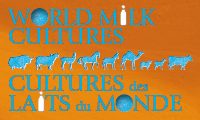Événements
Ocha Symposium World Milk Cultures, Paris, May 6th and 7th, 2010
Date
MILK, A UNIVERSAL FOODSTUFF
Human narratives and sustainability based on the diversity of dairy ecosystems
This coming May 6 and 7, 2010, an international symposium organized by OCHA on World Milk Cultures will be held at the National Museum of Natural History
in Paris, France. This symposium will bring together nearly 300 specialists including over 20 researchers in the human and social sciences and in the life sciences from a number of different countries (the United States, Ethiopia, India, Japan, Mexico, Senegal and so on), who will present the results of their most recent research. This symposium will be introduced by Bertrand Hervieu, Inspector-General for Agriculture, and organized into 4 sessions: Milk and origins, presided by Jean-Denis Vigne, archeozoologist, CNRS/Museum; Milk, man, culture and society, presided by Catherine Baroin, anthropologist, CNRS; Dairy land, sustainable land, presided by Bernard Faye, veterinarian and specialist on dairy breeding in tropical regions, INRA/CIRAD; To each his own milk, presided by Françoise Sabban, sinologist,
EHESS. Several main ideas emerge from their work:
Milk consumption dates back about 10,000 years
Regular consumption of milk and dairy products dates back to the early stages of livestock herding, between 11,000 and 6000 years ago, depending on the region of the world. Morphometric and paleogenetic studies (DNA) of animal bones are used to determine whether the animals were bred for their meat or for their milk. In the West, archeochemical research on organic residue,especially lipids, absorbed by archeological ceramics have confi rmed that milk exploitation was contemporary with the birth of ceramics, i.e. 7000 BE. The Veda – the foundational metaphysical and poetic work of Hinduism, which accords a primordial role to the cow, milk and butter in food and rituals – dates back to the second century BE.
Milk in food cultures: the surprise comes from China
Contrary to what is commonly believed, China did not discover milk in the late 20th century: the fi rst known Chinese agricultural treatise, which dates from 535, attests to highly developed dairy skills. Europe, the Middle East, the Maghreb and sub-Saharan Africa as well as the high plateaus of Central Asia – from Turkey to Mongolia – and India are lands that are well known for their ancient dairy tradition. This symposium also gives pride of place to Africa, with information on the Toubou, neighbors of the Tuaregs, in the Sahara and the Sahel, on the Peuls, on Senegal and also on Ethiopia where butter is made from fermented milk instead of fresh milk as in other countries. America proves to be the latecomer, but Mexico boasts over thirty traditional cheeses that date back more than 400 years and those made in Wisconsin would apparently do well to adopt a strategy similar to that of our European PDO cheeses.
Milk at the heart of sustainable development, from industrialized to emerging nations.
Sustainable dairy production is fi rst of all environmental: it is related to the diversity of the species adapted to different types of spaces, breeding practices that promote local food sources and bio-diversity and help maintain the landscape and produce fi nished products that express territorial identities. Sustainability is also economic, with the issue of the price of milk and hence remuneration of the various sector actors crucial to maintaining production and processing activities. Sustainability is social as well, for milk is an element of culture (uses, cuisine, traditional nutritional attributes or health claims, imaginary constructs, etc.) and helps to preserve rural and/or periurban activity that creates a considerable number of jobs. It should be noted that milk, a product that is “harvested” daily, and traditional dairy products, are food-producing activities that are vital in the literal sense for those who do not have enough to eat (one billion people out of the six billion on our planet), many of whom are very small-scale breeders.
Very different types of dairy farming systems throughout the world.
In France, an intermediate model: 45 heads of cattle and a strong link to the land.
This survey of world milk cultures points up the diversity of dairy systems. Farms with two or three cows are the most common in developing countries, and constitute a majority in the world. The Californian dairy farms with their herds of 1000 cows or more are not really representative of dairy farming in the United States, dairy farms in Wisconsin, a major dairy state, for instance have between 80 and 100 cows on about one hundred hectares. Nor are such herds a feature of France, where dairy farms have on average 45 dairy cows on a Usable Agricultural Area of 74 hectares, 59 of which is grazing area which accounts for 95% of the herd’s forage and where cows are put out to grass pastures in the spring.
A high level of lactase persistence into adulthood, an adaptive advantage of the human species.
Lactase, the enzyme that enables the digestion of lactose – milk sugar – is present in mother’s milk as well as in animal milk, but naturally diminishes after weaning, once the infant is no longer fed solely on milk. But lactase activity remains high in some populations that developed diary breeding due to the dual effect of genetic and cultural processes. This is why many researchers believe it constitutes an adaptive advantage for the human species even if they don’t understand exactly why. However, lactase is not required to digest yoghurt and fermented milk, because the lactose in them is predigested, or cheese, which only contains trace amounts, and even people lacking a high level of lactase persistence can digest a little bit of liquid milk, especially if it has been cooked.
CONTENTS
– Read the press release
“QUESTIONS & ANSWERS” with the Presidents of the four sessions:

